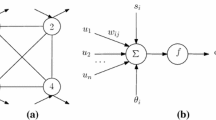Abstract
A principle of integrating neural network modules based on chaotic dynamics was studied on our two-moduled Nozawa model. Chaotic neural networks represent each embedded pattern as a low-dimensional periodic orbit, and the others are shown as high-dimensional chaotic attractors. This is equivalent to W. Freeman’s “I don’t know” and “I know” states. In particular, we noted that the combination of two-way inputs to each neural network module conflicted with embedded Hebbian correspondence. It was found that the interaction between the modules generated a novel “I know” state in addition to the embedded representation. Chaotic neural network modules can autonomously generate novel memories or functions by this interaction. The result suggests a functional integration in neural networks as it ought to be, e.g., feature binding and gestalt.
Similar content being viewed by others
Explore related subjects
Discover the latest articles, news and stories from top researchers in related subjects.References
Jacobs RA, Jordan MI (1991) Task decomposition through competition in a modular connectionist architecture: the what and where vision tasks. Cognitive Sci 15:219–250
Kobayashi N, Iwata A (1993) Multi-module neural network model for higher order association. In: Proceedings IJCNN-93, vol I, pp 233–236
Happel BLM, Murre JMJ (1994) The design and evolution of modular neural network architectures. Neural Networks 7:985–1004
Gallinari P (1995) Modular neural net systems: training of. In: Arbib MA (ed) The handbook of brain theory and neural networks. MIT Press, Cambridge, pp 582–583
Freeman WJ, Skarda CA (1985) Spatial EEG patterns, nonlinear dynamics and perception: the neo-Sherringtonian view. Brain Res Rev 10:147
Tsuda I (1992) Dynamic link of memory—chaotic memory map in nonequilibrium neural networks. Neural Networks 5:313–326
Adachi M, Aihara, K, Kotani M (1992) Nonlinear associative dynamics in a chaotic neural network. In: Proceedings of the 2nd International Conference on Fuzzy Logic and Neural Networks, pp 947–950
Nara S, Davis P, Totsuji H (1993) Memory search using complex dynamics in a recurrent neural network model. Neural Networks 6:963
Freeman WJ (1994) Neural mechanisms underlying destabilization of cortex by sensory input. Physica D 75:151
Ishii S, Sato M (1998) Associative memory based on parametrically coupled chaotic elements. Physica D 121:344–366
Sano A (1998) Integrating neural network modules based on chaos, and its pattern recalling and internal dynamics (in Japanese). IEICE Technical Report, NC98-63
Sano A, Kunifuji S (1998) Integration of chaotic behavior modules into a flow-typed two-body neural network model. Electron Commun Jpn, Part III, 81(5):41–50
Nozawa H (1992) A neural network model as a globally coupled map and applications based on chaos. Chaos 2:377–386
Hopfield JJ (1982) Neural networks and physical systems with emergent collective computational abilities. In: Proceedings of National Academy of Sciences USA, vol. 79, pp 2554–2558
Aihara K, Takabe T, Toyoda M (1990) Chaotic neural networks. Phys Lett A 144:333
Sano A (1995) The role of intersubsystem coupling density and chaotic dynamics in multi-body neural network model. In: Proceedings of IIW95, RWC Technical Report TR-95010, RWCP, pp 41–53
Hebb DO (1949) Organization of behavior. Wiley, New York
Author information
Authors and Affiliations
Corresponding author
About this article
Cite this article
Sano, A. Generating novel memories by integration of chaotic neural network modules. Artif Life Robotics 4, 42–45 (2000). https://doi.org/10.1007/BF02481476
Received:
Accepted:
Issue Date:
DOI: https://doi.org/10.1007/BF02481476




